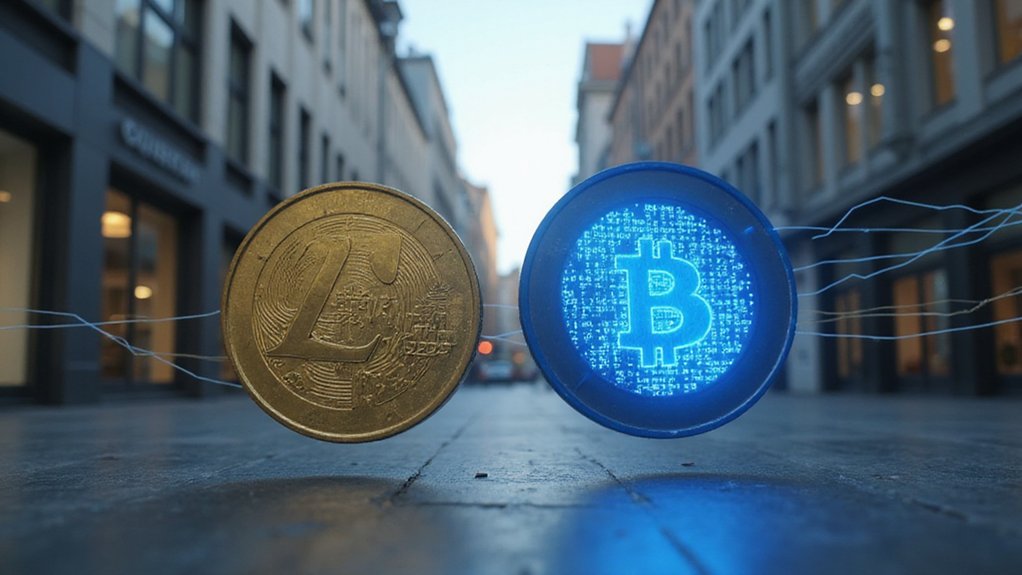Euro-pegged stablecoins represent a fascinating paradox: challenging the institutional euro while simultaneously extending its reach. These digital assets—growing at 115% annually to €4.1 trillion—offer continuous operation, borderless transfers, and immutable records without sacrificing the euro’s stability. Meanwhile, the ECB navigates this complex terrain, balancing innovation with sovereignty as Slovenia pioneers tokenized bonds. The inevitable convergence of traditional and decentralized euro variants promises a monetary evolution that few financial institutions appear truly prepared for.

While traditional finance has long debated the merits of various monetary instruments, the emergence of stablecoins has introduced a fascinating dichotomy within the European financial landscape.
These digital assets—pegged 1:1 to the euro through equivalent reserves—offer blockchain-based efficiency and transparency, disrupting a monetary ecosystem previously dominated by centralized institutions (who, one might note, have not always prioritized such transparency).
The euro, that stalwart of continental commerce overseen by the European Central Bank across 20 member states, continues to function as established legal tender with monetary policy backing.
The euro remains Europe’s financial backbone—a policy-backed legal tender spanning 20 nations under ECB’s vigilant stewardship.
Yet its digital transformation seems inevitable, particularly as EU policymakers advocate for a digital euro to preserve monetary sovereignty against the encroaching dominance of dollar-backed alternatives.
The irony is palpable: the very technology once dismissed as fringe now represents a strategic imperative for maintaining economic autonomy.
Euro-pegged stablecoins like EURC, EURT, and EURCV have carved out a compelling value proposition through their enhanced cross-border payment capabilities.
While traditional euro transfers remain beholden to banking hours and intermediary fees, these blockchain-based variants operate continuously, offering immutable transaction records and frequently reducing costs.
For e-commerce participants particularly, the integration with crypto payment gateways has simplified euro-denominated transactions both online and in physical locations.
The stablecoin market has seen remarkable growth with a 115% year-over-year increase in monthly transfer volumes, reaching €4.1 trillion in February 2025.
The regulatory landscape, predictably, continues to evolve.
European authorities are simultaneously experimenting with tokenized securities and sovereign bond issuance via blockchain while establishing guardrails to protect eurozone economic integrity. Slovenia has already positioned itself as a pioneer in this space, becoming the first eurozone country to issue a tokenized sovereign bond on blockchain technology.
Emerging stablecoin platforms increasingly utilize smart contracts to automate transactions when predefined conditions are met, eliminating the need for intermediaries in complex financial processes.
This regulatory tightrope—encouraging innovation while preserving monetary control—may determine which system ultimately prevails.
Perhaps the most telling development is the EU’s tacit acknowledgment that reserve currencies must offer competitive digital alternatives to survive.
As stablecoins continue expanding their market footprint and the ECB advances its digital euro initiative, the distinction between “traditional” and “alternative” currency grows increasingly blurred.
The future, it seems, lies not in competition between stablecoins and the euro but in their inevitable convergence.
Frequently Asked Questions
How Do Stablecoins Impact Traditional Banking Systems?
Stablecoins create a curious duality for traditional banking—potentially disintermediating financial institutions by offering narrow-banking alternatives without credit creation, while simultaneously creating new reserve dynamics when users shift deposits into stablecoin systems.
This reshuffling of liabilities, particularly evident when cash flows into reserve-backed digital assets, can alter banks’ lending capabilities and balance sheet compositions, though impacts vary substantially depending on whether the banking system remains constrained or unconstrained by regulatory capital requirements.
Are Stablecoins More Vulnerable to Cyberattacks Than the Euro?
Stablecoins demonstrably present greater vulnerability to cyberattacks than the Euro, primarily due to their reliance on smart contracts and blockchain infrastructure.
The $49.5 million USDC theft from @0xinfini exemplifies risks absent in the Euro’s centralized, regulated system.
While traditional banking faces its own security challenges, stablecoins operate in a nascent regulatory environment without the established security protocols that protect fiat currencies.
This technological disparity—decentralized versus centralized infrastructure—creates an inherent security differential that developers are racing to address.
Can Stablecoins Facilitate Cross-Border Payments Better Than Traditional Currencies?
Stablecoins indeed offer compelling advantages over traditional currencies for cross-border payments, including faster settlement times (minutes versus days), lower transaction fees, and enhanced transparency through blockchain’s data capabilities.
Their price stability relative to cryptocurrencies makes them practical for business transactions, while centralized infrastructure enables regulatory compliance.
However, traditional currencies still benefit from established legal frameworks and institutional trust—advantages stablecoins haven’t fully replicated.
The future likely involves hybrid systems where stablecoins complement rather than wholly replace conventional payment rails.
What Regulatory Challenges Do Stablecoins Face in Europe?
Stablecoins in Europe face substantial regulatory hurdles under MiCA, which categorizes them as either Asset-Referenced Tokens or E-Money Tokens—a distinction with profound compliance implications.
By Q1 2025, non-compliant tokens face delisting from crypto platforms, creating a market reshuffling that would make even seasoned financial planners wince.
The authorization process is rigorous, with national regulators scrutinizing applications while platforms simultaneously juggle consumer awareness campaigns—a regulatory tightrope walk with considerable market consequences.
How Might Stablecoins Affect Monetary Policy Implementation?
Stablecoins could fundamentally reshape monetary policy implementation through several mechanisms.
By potentially reducing demand for central bank reserves, they might alter liquidity dynamics in financial markets.
Their collateralization choices—whether government securities or commercial assets—could impact interest rate transmission channels.
Central banks may face challenges in their lender-of-last-resort function when stablecoin providers face liquidity crunches.
Additionally, during market stress, their flight-to-quality behavior introduces new variables into the equation that monetary authorities must monitor and address.









